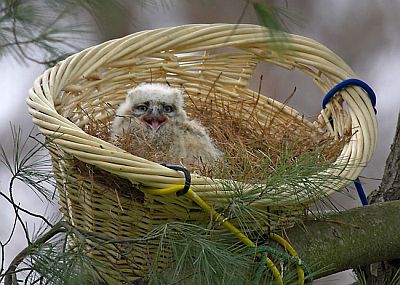 What do you do when a baby bird falls from the nest? You – or the bird rescuers – put it back in the nest of course.
What do you do when a baby bird falls from the nest? You – or the bird rescuers – put it back in the nest of course.
But what if the nest is too high to reach or it blew out of the tree? The bird rescuers have an elegant solution. It’s called re-nesting.
Pictured here is a baby great-horned owl re-nested by Tri-State Bird Rescue of Newark, Delaware. My friend Kim Steininger volunteers for them as a transporter and raptor re-nester. She sent me her photo of a re-nested great-horned owl and told me how it’s done.
When a raptor nestling is displaced, time is of the essence. Many birds imprint on their caregivers. If those caregivers are their parents, the babies learn how to communicate with their own species, what to eat and how to hunt. If they imprint on humans, they never learn how to be a bird and die of starvation in the wild. So it’s important to return a nestling to its parents very quickly.
As soon as a displaced nestling is reported to TSBR they make sure of the location of its original nest. After examining the bird to confirm it’s in good physical condition, the rescue team goes into action. Using bungie cords and a wicker basket, they secure the basket in a tree as close as possible to the original nest. They line the basket with pine needles, then put the baby in a cloth bag and carefully raise it to the basket using a long rope as a pulley. The baby is gently placed in its substitute nest. Then everyone leaves the area, hoping the parents will find it and care for it.
If the area is left undisturbed, this usually doesn’t take long. The wicker basket doesn’t matter to the parents. Their baby does. Kim tells me that last week her team re-nested a baby great-horned owl whose parents were so thrilled that they hooted a long duet.
The parents bring food to the baby in the basket and climb in the basket to shelter their nestling from the cold. In cases where there are still babies in the original nest the parents divide their duties, one parent staying with the original nest, the other with the wicker basket.
In the end the baby grows up and walks the nest edge on its way to fledging. You can see how they do this if you click on the picture.
Tri-State Bird Rescue cares for birds in Delaware, southeastern Pennsylvania, southwestern New Jersey and eastern Maryland. If you find an injured or displaced bird in that area, call TSBR at 302-737-9543. If you’re in the Pittsburgh area, call the Animal Rescue League Wildlife Center at 412-793-6900.
(all photos by Kim Steininger)
This time of year Kim dons a Spiderwoman persona. She is an agile tree climber and dedicated renester. Nothing stops her!
All my time in Pittsburgh’s woods and I have yet to stumble across the elusive great horned owl nesting……not sure if I want to because I like my scalp but it would be cool to see